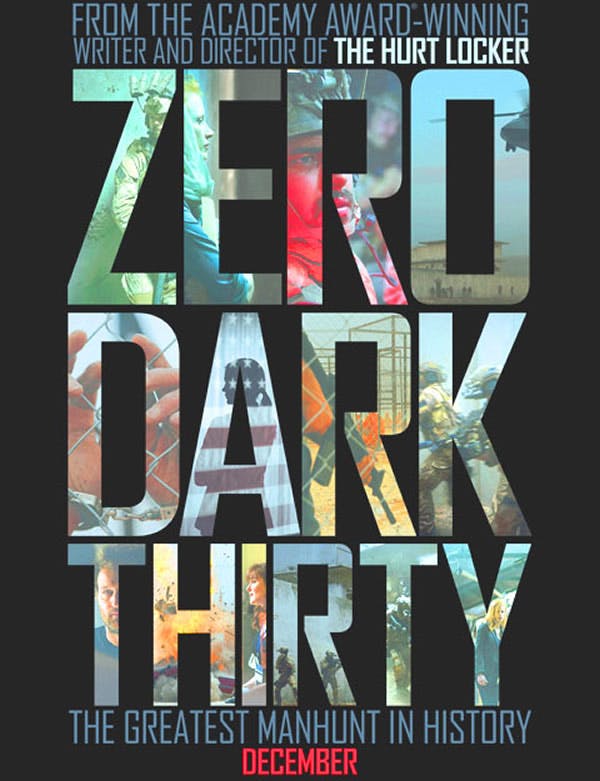Editor’s Note: With the Academy Awards drawing near, TLNT again asked some prominent thought leaders to write about their favorite movie from this past year with a HR or talent management theme. We’ll feature one each day leading up to the Oscars ceremony on Feb. 24.
By Patti Johnson
Zero Dark Thirty isn’t just about the hunt for Osama bin Laden.
Even if you haven’t seen this Best Picture-nominated film, you already know the climax of the story. But, you don’t know about Maya, a CIA operative who was obsessed with finding bin Laden to the exclusion of everything else.
Zero Dark Thirty is her story, too.
I‘ve never ever seen a better “challenge the status quo” example from one individual force of nature. Maya relied on information, knowledge and conviction. She was a flawed heroine who was so obsessed with her goal that she almost lost herself in the end. But, she did what she set out to do.
Did the talent and organization around this quest make it easier or harder to accomplish her elusive goal? Well, it did both – probably much like in real life.
Disruptive talent
Maya knew everything there was to know about the prior intelligence, the habits of terrorist organizations in the Middle East region, and where it made sense for bin Laden to be. Her off-the-charts expertise combined with her confidence were riveting.
She was highly respected, and as a result, and it gave her the right to question and push hard at anyone – and she usually did. She challenged the old conventional wisdom head on.
Maya mixed data and analysis with fresh logic and delivered her conclusions with a powerful confidence. After being challenged that she couldn’t prove it was Bin Laden at the compound in Pakistan, she replied, “You get the point. If you can’t prove it is bin Laden, prove it’s not someone else.”

She also was willing to sacrifice her position at the CIA for what she believed was right. She was obsessive, singularly focused, and disruptive. In this situation, these qualities counter-balanced the skepticism and fatigue in the organization surrounding this decade long search.
This film portrayal is a vivid reminder that remarkable talent that brings innovation, changes the status quo, and sets a new course will certainly make some waves in the process.
A powerful counter balance to hierarchy
Maya pushed and demanded that she get the resources in order to keep the intelligence trail warm. Her relentless pursuit of progress was continuous and visible. She kept a count on her boss’ office window of how many days it had been with no action.
After facing more and more delays and roadblocks, she finally tells her boss to either give her what she needs to pursue the intelligence, or, transfer her back to Washington. She got what she wanted.
Before meeting with the President, the CIA Director requested a briefing with the CIA team to decide if they should plan the raid to get Bin Laden. Maya, the unquestionable expert and leader of the intelligence assessment, started to sit at the executive table, but was told to move to a second row by the wall. The impact of the traditional hierarchy appeared, and being a woman probably didn’t help.
As she listened, her boss at the CIA was asked the probability that Bin Laden was hiding there. “There’s a 60 percent probability he’s there,” he replied. Another official added, “I will say it is a soft 60, sir.” Maya, from the back of the room, says, “It’s a 100 percent. OK, 95 percent because I know certainty freaks you guys out, but it’s a 100 percent he’s there.”
In the movie, the U.S. intelligence hierarchy and layers of supervisors got in the way of quick action based on a changing and complex intelligence picture drawn from thousands of sources. The hierarchy was successful at managing traditional risk, but it became an obstacle when the situation called for more rapid predictions and judgment.
Flawless planning to flawless execution
Even though the story of the landing at bin Laden’s Pakistan compound that night is widely known, it was astounding to watch the film re-enactment. The Navy Seals are obviously trained for dangerous situations far beyond what most can imagine, yet this mission was painstakingly planned with every contingency considered.
Even the crash of one helicopter at the bin Laden compound seemed more of a slight change in plans than a catastrophic event. There was a well-established Plan B — and it was executed perfectly. The Seals going into the compound trusted the other team members to deal with the helicopter problem and went on with the raid.
They were prepared for any contingency and trusted that everyone knew their role regardless of the circumstances. Surely their model is something we can all aspire to for any important event – even if bravery isn’t required. The organizational culture of preparedness and planning clearly set the stage for success.
Meeting the goal, paying the price
I left the theater after Zero Dark Thirty mentally exhausted.
In movies based on historical events, we know that not everything happened quite that way in real life. But, the organization and talent behind this story reminded me of the unbelievable impact of the disruptors who challenge the status quo, not for their own personal benefit, but for the ultimate goal. And it was not just Maya who did this, but her countless partners and colleagues who also never gave up.
The movie ended with Maya being flown out alone on a military plane back to the U.S. The pilot asks her where she wants to be taken, and Maya pauses and before responding, “I don’t know.”
Her relentless pursuit caused her to achieve the goal she had worked for continuously for over 10 years, but she paid a high price.
http://www.youtube.com/watch?v=cAtWcvCxPhc
Read more from Patti Johnson on PeopleResult’s Current blog.
